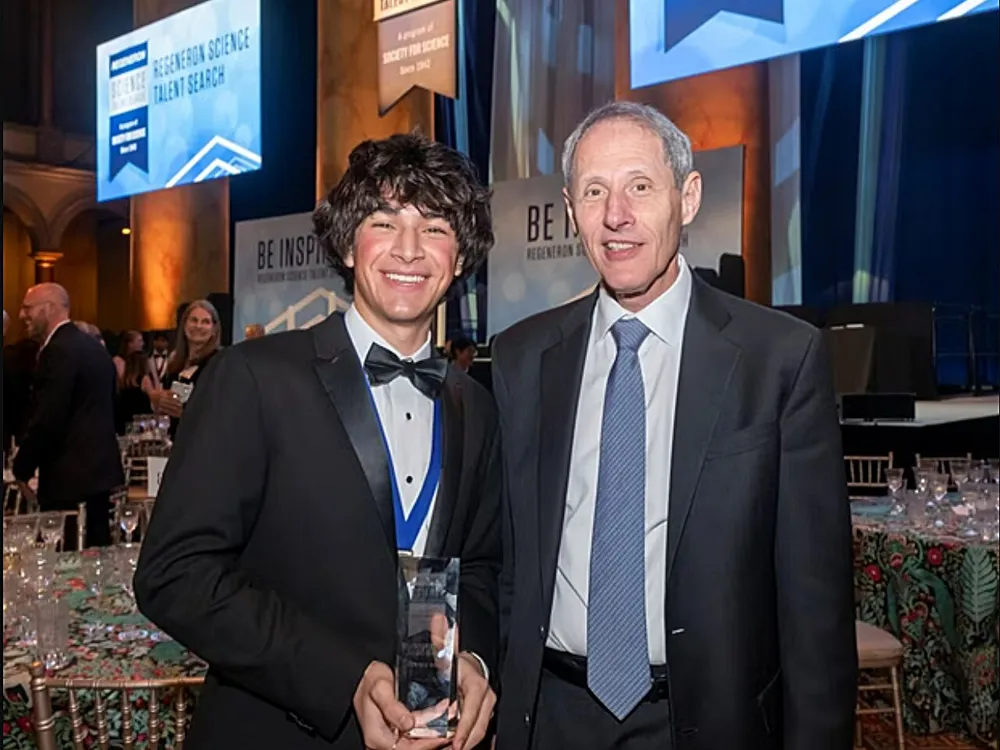High School Student Discovers 1.5 Million Potential New Astronomical Objects by Developing an A.I. Algorithm
High School Student Discovers 1.5 Million Potential New Astronomical Objects by Developing an A.I. Algorithm
The 18-year-old won $250,000 for training a machine learning model to analyze understudied data from NASA’s retired NEOWISE telescope
Matteo Paz with Caltech President Thomas F. Rosenbaum after winning the Regeneron Science Talent Search award.
California Institute of Technology
In a leap forward for astronomy, a researcher has developed an artificial intelligence algorithm and discovered more than one million objects in space by parsing through understudied data from a NASA telescope.
The breakthrough is detailed in a study published in November in The Astronomical Journal. What the study doesn’t detail, however, is that the paper’s sole author is 18 years old.
Matteo Paz from Pasadena, California, recently won the first place prize of $250,000 in the 2025 Regeneron Science Talent Search for combining machine learning with astronomy. Self-described as the nation’s “oldest and most prestigious science and math competition for high school seniors,” the contest recognized Paz for developing his A.I. algorithm. The young scientist’s tool processed 200 billion data entries from NASA’s now-retired Near-Earth Object Wide-field Infrared Survey Explorer (NEOWISE) telescope. His model revealed 1.5 million previously unknown potential celestial bodies.
“I was just happy to have had the privilege. Not only placing in the top ten, but winning first place, came as a visceral surprise,” the teenager tells Forbes’ Kevin Anderton. “It still hasn’t fully sunk in.”
Pasadena high schooler earns top science award
Watch on
Paz’s interest in astronomy turned into real research when he participated in the Planet Finder Academy at the California Institute of Technology (Caltech) in summer 2022. There, he studied astronomy and computer science under the guidance of his mentor, Davy Kirkpatrick, an astronomer and senior scientist at the university’s Infrared Processing and Analysis Center (IPAC).
Kirkpatrick had been working with data from the NEOWISE infrared telescope, which NASA launched in 2009 with the aim of searching for near-Earth asteroids and comets. The telescope’s survey, however, also collected data on the shifting heat of variable objects: rare phenomena that emit flashing, changing or otherwise dynamic light, such as exploding stars. It was Kirkpatrick’s idea to look for these elusive objects in NEOWISE’s understudied data.
“At that point, we were creeping up towards 200 billion rows in the table of every single [NEOWISE] detection that we had made over the course of over a decade,” Kirkpatrick explains in a Caltech statement. “So, my idea for the summer was to take a little piece of the sky and see if we could find some variable stars. Then we could highlight those to the astronomic community, saying, ‘Here’s some new stuff we discovered by hand; just imagine what the potential is in the dataset.’”
Paz, however, had no intention of doing it by hand. Instead, he worked on an A.I. model that sorted through the raw data in search of tiny changes in infrared radiation, which could indicate the presence of variable objects. Paz and Kirkpatrick continued working together after the summer to perfect the model, which ultimately flagged 1.5 million potential new objects, including supernovas and black holes.
“Prior to Matteo’s work, no one had tried to use the entire (200-billion-row) table to identify and classify all of the significant variability that was there,” Kirkpatrick tells Business Insider’s Morgan McFall-Johnsen in an email. He adds that Caltech researchers are already making use of Paz’s catalog of potential variable objects, called VarWISE, to study binary star systems.
“The variable candidates that he’s uncovered will be widely studied,” says Amy Mainzer, NEOWISE’s principal investigator for NASA, to Business Insider.
As for the A.I. model, Paz explains that it might be applicable to “anything else that comes in a temporal format,” such as stock market chart analysis and atmospheric effects like pollution, according to the statement. It’s no surprise the teenager is interested in the climate—as fires burned in L.A. earlier this year, the Eaton Fire forced him and his family to evacuate their home, Forbes
Other teenage scientists recognized by the contest studied mosquito control, drug-resistant fungus, the human genome and mathematics.
“The remarkable creativity and dedication of these students bring renewed hope for our future,” Maya Ajmera, president of the Society for Science, which oversees the award, says in a statement. “Driven by their ingenuity, these young scientists are developing groundbreaking solutions that have the potential to transform our world and propel society forward.”
Get the latest stories in your inbox every weekday.


